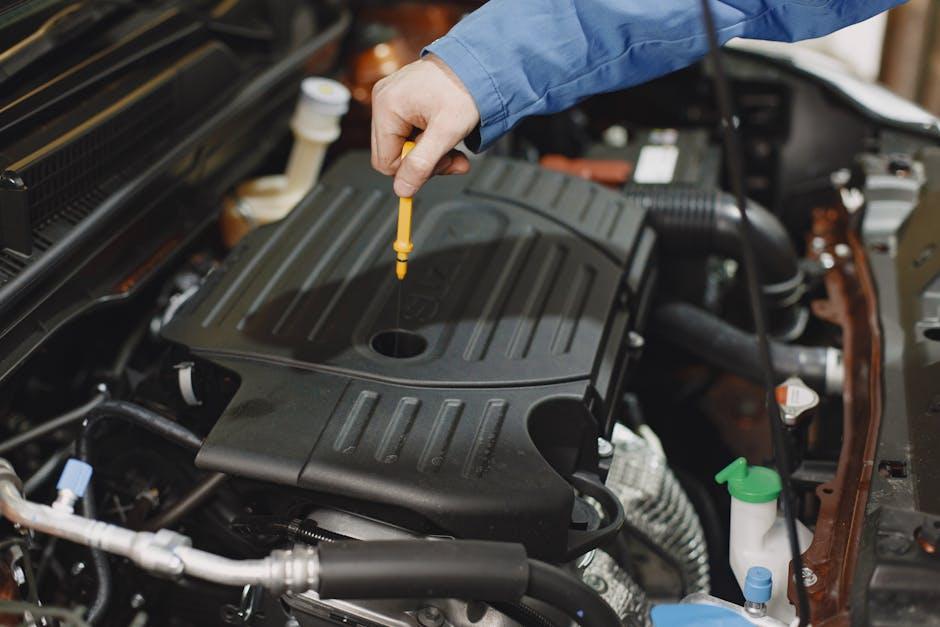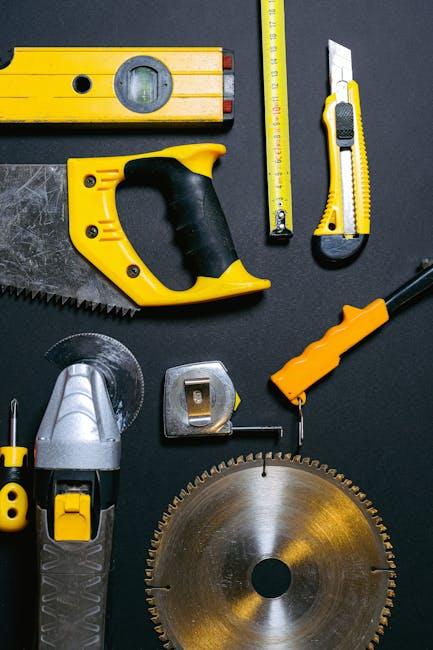Imagine your vehicle as a living, breathing machine — every part working in harmony to take you where you need to go. Among its many vital components, the transmission plays a starring role, quietly shifting gears and delivering power smoothly beneath the hood. But like any intricate system, it needs proper care to perform at its best. One simple yet essential maintenance task is checking the transmission fluid level. This often-overlooked step can prevent costly repairs and keep your ride running smoothly. In this article, we’ll walk you through how to check your transmission fluid level, empowering you to take control of your car’s health with confidence.
Table of Contents
- Understanding the Importance of Transmission Fluid
- Preparing Your Vehicle for an Accurate Fluid Check
- Locating the Transmission Fluid Dipstick with Confidence
- Step-by-Step Guide to Measuring Fluid Level Correctly
- Interpreting Fluid Color and Texture for Transmission Health
- Maintenance Tips to Keep Your Transmission Fluid Optimal
- Q&A
- To Wrap It Up

Understanding the Importance of Transmission Fluid
Transmission fluid plays a crucial role in keeping your vehicle’s transmission system functioning smoothly. Acting as both a lubricant and coolant, this fluid ensures that gears shift effortlessly and reduces friction between metal components. Without proper fluid levels, you risk overheating, excessive wear, and potential transmission failure, which can lead to costly repairs. Regularly checking the fluid helps you identify leaks early and maintain optimal vehicle performance.
When inspecting transmission fluid, focus not only on the level but also on its color and smell. Healthy transmission fluid typically boasts a bright red hue and should have a slightly sweet or tart scent. If you notice it turning dark brown or a burnt odor, this signals contamination or overheating. Proper maintenance includes:
- Regularly measuring the fluid level with the engine warm and running
- Using manufacturer-recommended fluid types
- Scheduling fluid changes as per your vehicle’s service intervals
| Fluid Condition | Meaning | Recommended Action |
|---|---|---|
| Bright Red & Clear | Healthy and optimal | Maintain regular schedule |
| Dark Brown | Aged and dirty | Change fluid soon |
| Burnt Smell | Overheated or oxidized | Inspect and replace immediately |

Preparing Your Vehicle for an Accurate Fluid Check
Before diving into checking your transmission fluid, ensure your vehicle is parked on a level surface and the engine is warmed up. This is crucial because transmission fluid expands with heat, and a cold measurement can result in misleading levels. Engage the parking brake for safety and keep the car running during the process unless your manufacturer advises otherwise. Gathering all necessary tools beforehand, such as clean gloves, a lint-free rag, and the vehicle’s owner’s manual, can save you from mid-check interruptions and help you follow model-specific instructions precisely.
Next, identify the transmission dipstick, usually marked clearly and located near the rear of the engine bay. Some modern vehicles might not have a traditional dipstick, so refer to your manual for the designated checking point. When ready, pull out the dipstick and wipe it clean before reinserting it fully—this first wipe removes old fluid traces and provides a true reading on the second pull. Remember, never trust the fluid color or level from the initial check; always perform a thorough and careful second dipstick inspection to avoid misreading:
- Check fluid color: Healthy fluid is translucent reddish or pink.
- Note fluid level: It should be between the ‘Full’ and ‘Add’ marks.
- Inspect fluid condition: Avoid dark, cloudy, or burnt smells.
| Step | Tip for Accuracy |
|---|---|
| Warm engine | Drive 10-15 mins for optimal fluid temp |
| Park level | Ensure car is on flat ground |
| Dipstick handling | Wipe clean before checking |

Locating the Transmission Fluid Dipstick with Confidence
Identifying the transmission fluid dipstick may seem intimidating at first, but with a few practical tips, you can locate it swiftly and safely. Most automatic transmissions feature a dipstick positioned near the back of the engine bay, often marked with a brightly colored handle—typically red, yellow, or orange—to catch your eye. Remember, it’s usually nestled closer to the firewall than the front of the engine, making it distinct from the engine oil dipstick. Before you start, consult your vehicle’s owner’s manual to confirm the exact location specific to your model, as designs can vary significantly across manufacturers and years.
To help in your search, keep these pointers in mind:
- Look for a long, slender handle protruding near the transmission housing.
- Focus on the area behind the engine, often under or around the battery or air filter box.
- Check the color coding, as many automakers use bright handles to differentiate the transmission dipstick.
| Car Make | Dipstick Location | Handle Color |
|---|---|---|
| Ford | Near firewall, right side | Yellow |
| Toyota | Left side, behind battery | Red |
| Honda | Back center of engine bay | Orange |

Step-by-Step Guide to Measuring Fluid Level Correctly
Before diving into the fluid check, ensure your vehicle is parked on a level surface and the engine is warm but turned off. Using the dipstick is key—start by locating it, usually marked with a bright handle inside the engine bay. Pull the dipstick out and wipe it clean with a lint-free cloth to remove residual fluid. Once wiped, reinsert the dipstick fully, then remove it again to observe the fluid level. Pay close attention to the markings; the fluid should fall between the “Full” and “Add” indicators for optimal performance. Too low can lead to transmission damage, while overfilling may cause leaks or foaming.
- Check fluid color: A healthy transmission fluid should be clear with a reddish tint.
- Note the fluid’s smell: A burnt odor signals the need for a fluid change.
- Temperature matters: Some vehicles require checking fluid level only when hot or cold; refer to your owner’s manual.
| Fluid Condition | Indication |
|---|---|
| Clear & Red | Good, no action needed |
| Dark Brown or Black | Requires fluid replacement |
| Burnt Smell | Immediate attention needed |

Interpreting Fluid Color and Texture for Transmission Health
When inspecting your transmission fluid, color and texture offer crucial clues to your transmission’s condition. Fresh, healthy fluid typically shines with a vibrant red or pink hue, signaling optimal performance and protection. As the fluid ages or encounters issues, it may darken to a brown or even blackish shade, indicating oxidation or burning. A cloudy or milky appearance can suggest the presence of water contamination, which impairs lubrication and can lead to serious transmission damage if not addressed promptly.
Texture complements color as an essential diagnostic tool. Transmission fluid should feel smooth and slippery, providing sufficient lubrication to the intricate gears inside. Gritty or grainy sensation when touched suggests metal shavings or debris suspended within, a warning sign of internal wear or damage. Below is a simple reference guide to help assess fluid health effectively:
| Fluid Characteristic | Indication | Recommended Action |
|---|---|---|
| Bright Red or Pink | Healthy, functioning fluid | Continue regular checks |
| Dark Brown or Black | Burnt or oxidized fluid | Immediate fluid replacement needed |
| Cloudy or Milky | Water contamination present | Flush transmission system |
| Gritty Texture | Possible internal wear | Inspect transmission components |

Maintenance Tips to Keep Your Transmission Fluid Optimal
Regular transmission fluid care ensures smooth gear shifts and extends the life of your vehicle’s transmission system. Start by checking the fluid level when the engine is warm; this helps get an accurate reading. Always park on a level surface and use the dipstick designed specifically for transmission fluid—usually labeled with a bright handle. If the fluid appears dark, smells burnt, or is gritty, it’s time for a change. Ignoring these signs can lead to costly repairs and diminished performance.
To maintain the ideal fluid condition, consider the following tips:
- Check fluid monthly or as recommended in your vehicle’s manual.
- Use manufacturer-approved transmission fluid types.
- Avoid overfilling to prevent leaks and pressure buildup.
- Don’t delay fluid replacement—age degrades lubricating properties.
| Fluid Color | Condition | Action |
|---|---|---|
| Bright Red | Healthy | Check regularly |
| Dark Brown | Old/Contaminated | Change fluid |
| Black or Smelly | Burnt | Immediate replacement |
Q&A
Q&A: How to Check Transmission Fluid Level
Q1: Why is it important to check the transmission fluid level?
A1: Transmission fluid lubricates and cools the transmission’s moving parts. Maintaining the correct fluid level ensures smooth shifting, prevents overheating, and extends the life of your transmission.
Q2: When should I check my transmission fluid?
A2: It’s best to check transmission fluid when your engine is warm and running, unless your vehicle’s manual specifies otherwise. This ensures an accurate reading, as fluid expands when heated.
Q3: What tools do I need to check the transmission fluid?
A3: Typically, you only need a clean rag or paper towel to wipe the dipstick and a pair of gloves if you prefer. Some vehicles have sealed transmissions without dipsticks, requiring a mechanic’s assistance.
Q4: How do I locate the transmission fluid dipstick?
A4: Open your vehicle’s hood and look for a dipstick labeled “transmission” or with a distinct handle color, often red or yellow. Consult your owner’s manual if you’re unsure.
Q5: What is the step-by-step process to check the fluid level?
A5:
- Park your car on a level surface and set the parking brake.
- Start the engine and let it warm up.
- With the engine running, shift through the gears briefly, then return to Park or Neutral.
- Pull out the transmission dipstick and wipe it clean.
- Reinsert the dipstick fully, then pull it out again to check the fluid level.
- The fluid should be between the “Full” and “Add” marks or within the crosshatched area.
Q6: How does transmission fluid look when it’s healthy?
A6: Healthy transmission fluid is usually bright red and translucent. If it’s dark brown or smells burnt, it’s time for a fluid change or professional inspection.
Q7: What should I do if the fluid level is low?
A7: Add the correct type of transmission fluid slowly, checking frequently to avoid overfilling. Always refer to your owner’s manual for the recommended fluid type and quantity.
Q8: Can I check transmission fluid on any vehicle?
A8: Not all vehicles have a transmission dipstick. Many modern cars use sealed transmissions. For those, fluid checks and changes should be done by a professional.
Q9: What are the risks of ignoring transmission fluid maintenance?
A9: Low or contaminated transmission fluid can cause shifting problems, overheating, and eventual transmission failure, leading to costly repairs.
Q10: Is checking transmission fluid something I can do myself?
A10: Yes! With basic knowledge and care, checking your transmission fluid is a simple DIY task that helps keep your vehicle running smoothly. However, when in doubt, seek professional advice.
Checking transmission fluid might seem like a small act, but it’s a vital step in preserving your car’s performance. Staying attentive to those crimson levels can save you from greasy troubles down the road.
To Wrap It Up
Checking your transmission fluid level might seem like a small part of vehicle maintenance, but it plays a crucial role in keeping your car running smoothly. By mastering this simple skill, you empower yourself to catch potential issues early, extend the life of your transmission, and avoid costly repairs down the road. Whether you’re a seasoned driver or a curious beginner, taking a few moments to peek under the hood and check that fluid can make all the difference on the road ahead. So next time you’re ready to hit the road, remember: a little attention to your transmission fluid today could mean many miles of trouble-free driving tomorrow.

